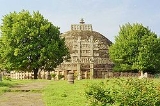
Mauryan art
Encyclopedia
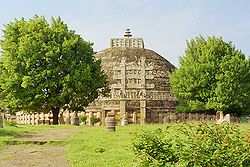
Indian subcontinent
The Indian subcontinent, also Indian Subcontinent, Indo-Pak Subcontinent or South Asian Subcontinent is a region of the Asian continent on the Indian tectonic plate from the Hindu Kush or Hindu Koh, Himalayas and including the Kuen Lun and Karakoram ranges, forming a land mass which extends...
. It represented an important transition in Indian art from use of wood to stone. It is also notable for a refinement in pottery.
Overview
According to Niharranjan RayNiharranjan Ray
Niharranjan Ray was an Indian historian, well-known for his works on history of art and Buddhism. he was born at Kayetgram village of Mymensingh District in Bengal province of British India . He completed his initial studies from the Mrityunjaya School and Anandamohan College in Mymensingh. In...
, the sum total of the Mauryan treasury of art include the remains of the royal palace and the city of Pataliputra, a monolithic rail at Sarnath
Sarnath
Sarnath or Sārnātha is the deer park where Gautama Buddha first taught the Dharma, and where the Buddhist Sangha came into existence through the enlightenment of Kondanna. Sarnath is located 13 kilometres north-east of Varanasi, in Uttar Pradesh, India...
, the Bodhimandala or the altar resting on four pilars at Bodhgaya, the excavated Chaitya-halls in the Barabar and Nagarjuni hills of Gaya including the Sudama cave bearing the inscription dated the 12th regnal year of Ashoka
Ashoka
Ashok Maurya or Ashoka , popularly known as Ashoka the Great, was an Indian emperor of the Maurya Dynasty who ruled almost all of the Indian subcontinent from ca. 269 BC to 232 BC. One of India's greatest emperors, Ashoka reigned over most of present-day India after a number of military conquests...
, the non-edict bearing and edict bearing pillars, the animal sculptures crowning the pillars with animal and vegetal reliefs decorating the abaci of the capitals and the front half of the representation of an elephant carved out in the round from a live rock at Dhauli.
Coomaraswmy
Ananda Coomaraswamy
Ananda Kentish Coomaraswamy was a Ceylonese philosopher and metaphysician, as well as a pioneering historian and philosopher of Indian art, particularly art history and symbolism, and an early interpreter of Indian culture to the West...
argued that the Mauryan art may be said to exhibit three main phases. The first phase was the continuation of the Pre-Mauryan tradition, which is found in some instances to the representation of the Vedic deities (the most significant examples are the reliefs of Surya
Surya
Surya Suraya or Phra Athit is the chief solar deity in Hinduism, one of the Adityas, son of Kasyapa and one of his wives, Aditi; of Indra; or of Dyaus Pitar . The term Surya also refers to the Sun, in general. Surya has hair and arms of gold...
and Indra
Indra
' or is the King of the demi-gods or Devas and Lord of Heaven or Svargaloka in Hindu mythology. He is also the God of War, Storms, and Rainfall.Indra is one of the chief deities in the Rigveda...
at the Bhaja Caves
Bhaja Caves
Bhaja Caves are a group of 22 rock-cut caves dating back to 200 BC located at Karli, near Lonavala, Maharashtra. The location of Bhaja caves is not far from location of Karla Caves and these are stylistically similar to the Karla Caves...
.) The second phase was the court art of Ashoka
Ashoka
Ashok Maurya or Ashoka , popularly known as Ashoka the Great, was an Indian emperor of the Maurya Dynasty who ruled almost all of the Indian subcontinent from ca. 269 BC to 232 BC. One of India's greatest emperors, Ashoka reigned over most of present-day India after a number of military conquests...
, typically found in the monolithic columns on which his edicts are inscribed and the third phase was the beginning of brick and stone architecture, as in the case of the original stupa
Stupa
A stupa is a mound-like structure containing Buddhist relics, typically the remains of Buddha, used by Buddhists as a place of worship....
at Sanchi
Sanchi
Sanchi is a small village in Raisen District of the state of Madhya Pradesh, India, it is located 46 km north east of Bhopal, and 10 km from Besnagar and Vidisha in the central part of the state of Madhya Pradesh. It is the location of several Buddhist monuments dating from the 3rd...
, the small monolithic rail at Sanchi and the Lomash Rishi cave in the Barabar Caves
Barabar Caves
The Barabar Caves are the oldest surviving rock-cut caves in India, mostly dating from the Mauryan period , and some with Ashokan inscriptions, located in the Jehanabad District of Bihar, India, 24 km north of Gaya....
, with its ornamentated facade, reproducing the forms of wooden structure.
Architecture
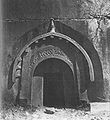
Arthashastra
The Arthashastra is an ancient Indian treatise on statecraft, economic policy and military strategy which identifies its author by the names Kautilya and , who are traditionally identified with The Arthashastra (IAST: Arthaśāstra) is an ancient Indian treatise on statecraft, economic policy and...
advises the use of brick and stone for their durability. Yet he devotes a large section to safeguards to be taken against conflagrations in wooden buildings indicating their popularity.
Megasthenes
Megasthenes
Megasthenes was a Greek ethnographer in the Hellenistic period, author of the work Indica.He was born in Asia Minor and became an ambassador of Seleucus I of Syria possibly to Chandragupta Maurya in Pataliputra, India. However the exact date of his embassy is uncertain...
mentions that the capital city of Pataliputra was encircled by a massive timber-palisade, pierced by loopholes through which archers could shoot. It had sixty-four gates and 570 towers. According to Strabo
Strabo
Strabo, also written Strabon was a Greek historian, geographer and philosopher.-Life:Strabo was born to an affluent family from Amaseia in Pontus , a city which he said was situated the approximate equivalent of 75 km from the Black Sea...
, the gilded pillars of the palace were adorned with golden vines and silver birds. The palace stood in an extensive park studded with fish ponds. It was furnished with a great variety of ornamental trees and shrubs. Excavations carried out by Spooner and Waddell have brought to light remains of huge wooden buildings at Bulandibagh and Kumrahar, both near Patna
Patna
Paṭnā , is the capital of the Indian state of Bihar and the second largest city in Eastern India . Patna is one of the oldest continuously inhabited places in the world...
. The remains of one of the buildings, a 80 pillared hall at Kumrahar are of particular significance. Out of 80 stone columns, that once stood on a wooden platform and supported a wooden roof, Spooner was able to discover the entire lower part of at least one in almost perfect conditions. It is more or less similar to an Ashokan pillar, smooth, polished and made of grey Chunar sandstone.

Sanchi
Sanchi is a small village in Raisen District of the state of Madhya Pradesh, India, it is located 46 km north east of Bhopal, and 10 km from Besnagar and Vidisha in the central part of the state of Madhya Pradesh. It is the location of several Buddhist monuments dating from the 3rd...
, Sarnath
Sarnath
Sarnath or Sārnātha is the deer park where Gautama Buddha first taught the Dharma, and where the Buddhist Sangha came into existence through the enlightenment of Kondanna. Sarnath is located 13 kilometres north-east of Varanasi, in Uttar Pradesh, India...
and probably Amaravati
Amaravati, Andhra Pradesh
Amaravathi is a small town situated on the banks of the River Krishna in the Guntur District of Andhra Pradesh, India. It is famous for its Amareswara temple dedicated to Lord Shiva. The temple is one of the famous Pancharamas. Amaravati, also known as Dhanyakataka/Dharanikota was the site of a...
were originally built as brick and masonry mounds during the reign of Ashoka
Ashoka
Ashok Maurya or Ashoka , popularly known as Ashoka the Great, was an Indian emperor of the Maurya Dynasty who ruled almost all of the Indian subcontinent from ca. 269 BC to 232 BC. One of India's greatest emperors, Ashoka reigned over most of present-day India after a number of military conquests...
. Unfortunately they were renovated many times, which leaves us with hardly a clue of the original structures.
Sculpture
This period marked an imaginative and impressive step forward in Indian sculpting. Although some would consider the Pillars of AshokaPillars of Ashoka
The pillars of Ashoka are a series of columns dispersed throughout the northern Indian subcontinent, erected or at least inscribed by the Mauryan king Ashoka during his reign in the 3rd century BCE. Originally, there must have been many pillars but only nineteen survive with inscriptions. Many are...
as architecture, owing to their free standing nature and elaborately carved animal capitals most of the art historians consider them as the examples of sculpture. Coomaraswamy
Ananda Coomaraswamy
Ananda Kentish Coomaraswamy was a Ceylonese philosopher and metaphysician, as well as a pioneering historian and philosopher of Indian art, particularly art history and symbolism, and an early interpreter of Indian culture to the West...
distinguishes between court art and a more popular art during the Mauryan period. Court art is represented by the pillars and their capitals. Popular art is represented by the works of the local sculptors like chauri (whisk)-bearer from Didarganj.
Pillars and their capitals
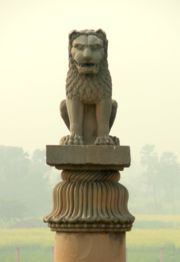
Chunar
Chunar छुनर شُنَر, located in Mirzapur District of Uttar Pradesh state, India, is an ancient town. The railway tracks passing through Chunar leads to major destinations of India, including Howrah, Delhi, Tatanagar and Varanasi. National Highway number 7 also passes through Chunar...
near Varanasi
Varanasi
-Etymology:The name Varanasi has its origin possibly from the names of the two rivers Varuna and Assi, for the old city lies in the north shores of the Ganga bounded by its two tributaries, the Varuna and the Asi, with the Ganges being to its south...
. The uniformity of style in the pillar capitals suggests that they were all sculpted by craftsmen from the same region. It would therefore seem, that stone transported from Mathura and Chunar to the various sites where the pllars have been found and here the stone was cut and carved by craftsmen They were given a fine polish characteristic of Mauryan sculpture. These pillars were mainly erected in the Gangetic plains. They were inscribed with edicts of Ashoka on Dhamma or righteousness. The animal capital as a finely carved lifelike representation. Noteworthy are the lion capital of Sarnath, the bull capital of Rampurva and the lion capital of Laurya Nandangarh. Much speculation has been made about the similarity between these capitals and Achaemenid works.
Examples of popular art
The work of local sculptors illustrates the popular art of the Mauryan period. This consisted of sculpture which may not probably was not commissioned by the emperor. The patrons of the popular art were the local governors and the more well-to-do subjects. It is represented by figures such as the female figure of Besnagar, the male figure of Parkham and the whisk-bearer from DidarganjDidarganj Yakshi
The Didarganj Yakshi is one of the finest examples of Mauryan art.The sculpture is currently located in the Patna Museum in Patna, India. It is 64" tall, carved out of a single piece of stone....
(although its age is debated). Technically they are fashioned with less skill than the pillar capitals. They express a considerable earthiness and physical vitality.
The stone elephant at Dhauli
Dhauli
Dhauli hills are located on the banks of the river Daya, 8 km south of Bhubaneswar in Orissa . It is a hill with vast open space adjoining it, and has major Edicts of Ashoka engraved on a mass of rock, by the side of the road leading to the summit of the hill...
was also probably carved by local craftsmen and not by the special craftsmen who were responsible for the animal capitals. The image of the elephant emerging from the rock is a most impressive one, and its purpose was probably to draw attention to the inscription nearby.
Terracotta objects of various sizes have been found at Mauryan sites. A continuation of the tradition of making mother-goddesses in clay, which dates back to the prehistoric period is revealed by the discovery of these objects at Mauryan levels during the excavations at Ahicchatra. They are found more commonly from Pataliputra to Taxila
Taxila
Taxila is a Tehsil in the Rawalpindi District of Punjab province of Pakistan. It is an important archaeological site.Taxila is situated about northwest of Islamabad Capital Territory and Rawalpindi in Panjab; just off the Grand Trunk Road...
. Many have stylized forms and technically they are more accomplished, in that they have a well-defined shape and clear ornamenation. Some appear to have been made from moulds, yet there is little duplication. Terracotas from Taxila consists of primitive idols, votive reliefs with deities, toys dice, ornaments and beads. Among the ornaments were round medallions, similar to the bullae worn by Roman boys. Ringstones probably associated with a fertility cult have also been found in some quantity. Terracotta images of folk gods and goddesses which have been found having an earthy charm.

Pottery
Use of the potters wheel became universal. The pottery associated with Mauryan period consists of many types of ware. But the most highly developed technique is seen in a special type of pottery known as the Northern Black Polished WareNorthern Black Polished Ware
The Northern Black Polished Ware culture of South Asia is an Iron Age culture, succeeding the Painted Grey Ware culture...
(NBP), which was the hallmark of Mauryan pottery. The NBP ware is made of finely levigated alluvial clay, which when seen in section is usually of a grey and sometimes of a red hue. It has a brilliantly burnished dressing of the quality of a glaze which ranges from a jet black to a deep grey or a metallic steel blue. Occasionally small red-brown patches are apparent on the surface. It can be distinguished from other polished or graphite-coated red wares by its peculiar lustre and brilliance. This ware was used largely for dishes and small bowls. It is found in abundance in the Ganges valley. Although NBP was not very rare, it was obviously a more expensive ware than the other varieties, since ptoshreds of NBP were occasionally found riveted with copper pins indicating that even a cracked vessel in NBP ware had its value.
Coins
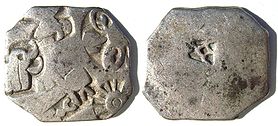
Money changer
A money changer is a person who exchanges the coins or currency of one country for that of another. This trade is thought generally to be the origin of modern banking in Europe....
) marks on them indicating that older coins were often re-issued. The alloy content closely resembles that specified in the Arthashastra. Based on his identification of the symbols on the punch-marked coins with certain Mauryan rulers, Kosambi argued that the Mauryan punch-marked karshapana after Chandragupta has the same weight as its predecessor, but much more copper, cruder fabric, and such a large variation in weight that the manufacture must have been hasty. This evidence of stress and unsatisfied currency demand is accompanied by debasement (inflation) plus vanishing of the reverse marks which denoted the ancient trade guilds. This in his opinion indicated that there was a fiscal crisis in the later Mauryan period. However his method of analysis and the chronological identification has been questioned.
Painting
While we can be sure of Mauryan proficiency in this field based on the descriptions of MegasthenesMegasthenes
Megasthenes was a Greek ethnographer in the Hellenistic period, author of the work Indica.He was born in Asia Minor and became an ambassador of Seleucus I of Syria possibly to Chandragupta Maurya in Pataliputra, India. However the exact date of his embassy is uncertain...
, unfortunately no proper representative has been found to date.

